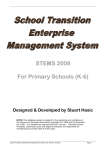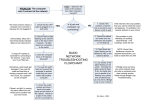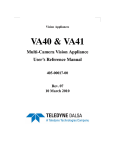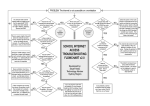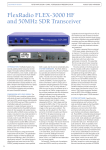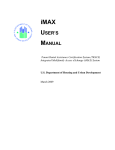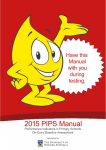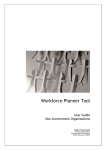Download STEMS for HS - StuHasic.com
Transcript
STEMS 2008 For High Schools (7-10/12) Designed & Developed by Stuart Hasic NOTE: This database system is subject to the guidelines and conditions of the Privacy and Personal Information Protection Act 1998 and the Education Act 1990. It is intended for internal NSW DET use only. Individual school Principals, authorised users and the District Superintendent are responsible for maintaining the private nature of this data. School Transition Enterprise Management System for High Schools Page 1 The School Transition Enterprise Management System User Manual for 7-12 Schools Fifth Edition published July 2008 STEMS Software and Documentation is Copyright 2002-2008 by Stuart Hasic: Australian and International Copyright Laws protect this document and accompanying software. No part of this document or accompanying software may be reproduced or transmitted in any form by any means without written permission from Stuart Hasic. DISCLAIMER: Steps have been taken to ensure that the information contained in this document is correct as at the time of publication. However, it is possible that changes to the software in the future may make this document out-dated. No responsibility will be taken for damage to or loss of data caused directly or indirectly as a result of the use of the information in this document. Licence Agreement This is a legal agreement between you, the end user and Stuart Hasic hereafter referred to as the DEVELOPER. By installing the ‘School Transition Enterprise Management System’ (STEMS), you are agreeing to be bound by the terms of this agreement as set out below. DEVELOPER’s Software Licence 1. GRANT OF LICENCE – Upon payment of the specified licence fee, the DEVELOPER grants an entire School District the right to use a specially personalised copy of the STEMS software program (the 'SOFTWARE') on as many computers as is required in district schools covering years Kindergarten through to year 12, as well as the District Office. This licence does NOT cover State Office use of the SOFTWARE. Both the licenced District’s schools and the District Office are granted the right to use a networked installation of the SOFTWARE on any number of networked workstations at a single site concurrently. A personalised copy of STEMS will not work for an unlicenced school district. 2. COPYRIGHT - The SOFTWARE is owned by the DEVELOPER and is protected by Australian Copyright laws and international treaty provisions. Therefore, you must treat the SOFTWARE like any other copyrighted material (e.g. a book or musical recording) except that you may make one copy of the SOFTWARE solely for backup or archival purposes. You may not copy the written materials accompanying the software for use of any type outside the school campus. 3. OTHER RESTRICTIONS - You may not rent, lease or transfer the SOFTWARE and/or accompanying written materials on either a temporary or permanent basis. You may not reverse engineer, decompile or disassemble the SOFTWARE. Limited Warranty The DEVELOPER warrants that the SOFTWARE will perform substantially in accordance with the accompanying written materials for a period of 90 days from the date of receipt. The DEVELOPER and his Authorised Distributors’ entire liability and your exclusive remedy shall be, at the DEVELOPER’s option, (a) return of the price paid for the licence or (b) repair or replacement of the SOFTWARE that does not meet the DEVELOPER’s Limited Warranty and which is returned to the Authorised Distributor with a copy of your invoice. This Limited Warranty is void if failure of the SOFTWARE has resulted from accident, abuse, or misapplication. Any replacement SOFTWARE will be warranted for the remainder of the original warranty period or 30 days, whichever is longer. NO OTHER WARRANTIES – The DEVELOPER and the Authorised Distributor disclaim all other warranties, either expressed or implied, including but not limited to implied warranties of merchantability and fitness for a particular purpose, with respect to the SOFTWARE and the accompanying written materials. This limited warranty gives you specific legal rights. You may have others which vary from state to state and country to country. NO LIABILITY FOR CONSEQUENTIAL DAMAGES - In no event shall The DEVELOPER nor the Authorised Distributor be liable for any damages whatsoever (including, without limitation, damages for loss of business profits, business interruption, loss of business information, or other pecuniary loss) arising from the use of or inability to use this product, even if the DEVELOPER or the Authorised Distributor have been advised of the possibility of such damages. Because some states do not allow the exclusion or limitation of liability for consequential or incidental damages, the above limitation may not apply to you. This Agreement is governed by the laws of the State of New South Wales, Australia. Should you have any questions concerning this Agreement, or if you wish to contact the DEVELOPER for any reason, please write to - Stuart Hasic via eMail at: [email protected] How to Get User Support for the STEMS Software: If you have encountered a problem with using STEMS, you should first take note of exactly what you were trying to do and what messages displayed or symptoms evident. The following resources should be used - in order - in obtaining support for the STEMS software: This user documentation http://stuhasic.com/stems Your Region’s STEMS Coordinator If there is still an unresolved problem, the District STEMS Coordinator should take full detail of the problem and report it to the DEVELOPER for prompt attention. School Transition Enterprise Management System for High Schools Page 2 Introduction: The School Transition Enterprise Management System (STEMS) has been designed to provide individual schools, entire school districts and education departments with necessary information about students progressing from Primary school (year 6) to High school (year 7). This single application is able to run in various modes: Primary School Mode: • • • • • • • • • • • • • Allows for the easy data entry of details of all students - K through 6 Exports base student details from OASIS and imports into the STEMS Import from OASIS whenever necessary to generate new STEMS records for new enrolments Specific K-6 student tracking form with Accident and Miscellaneous Info Registers Archives STEMS data for students that have left the school - archives can be reopened easily Includes a STEMS Photo Studio utility for the quick and easy taking of photographs of students and attaching them to each student's STEMS record Prints a data collection form for easy gathering of data Stores data covering student, academic and support profiles as well as comprehensive K-6 tracking information Prints a single page report for each student after data has been entered Allows for storage of user-definable student survey responses Dozens of reports and filters interact with MS Excel for customised reporting and evaluation of data - the perfect management tool Easy nomination of High School for year 6 students - all DET schools included Compresses, encrypts and electronically transfers completed year 6 data to the District Office District Office Mode: • • • • • • • • Receipt, decompression and import of all year 6 data from all primary schools in the District Automatic sorting of all students into groups based on their nominated high school Creation of separate databases of new year 7 students for each high school Compresses and electronically transfers all new year 7 data to each high school, respectively. (i.e. each high school only receives details about their new students) Identifies year 6 students enrolling in schools in other districts and transfers their details to the respective district office Identifies all students enrolling in religious and other non-government high schools, as well as those students moving interstate or overseas Provides a range of inquiries, filters and reports for management purposes Export of data and reports to MS Excel High School Mode: • • • • • • • • Receipt, decompression and import of all new year 7 data from various District Offices Import of student enrolment information for all students (7-12) from OASIS Manual STEMS data entry of students whose details were not automatically imported from Primary Schools Archives STEMS data of students that have left the school - archives can be reopened easily Includes a STEMS Photo Studio utility for the quick and easy taking of photographs of students and attaching them to each student's STEMS record Searching, sorting and reporting of data Export of data and reports to MS Excel Provides excellent planning information for school leaders and teachers School Transition Enterprise Management System for High Schools Page 3 What Data is Collected with STEMS ? STEMS stores information about all students, including: Student Profile: Cultural background, year, teacher, special talents, attendance, date of birth, etc. Academic Profile: Achievement in Maths and English, all BST Bands, ESL Phase, Behaviour/Attitude, etc. Support Profile: Health issues, Diagnosed Disorders, Special Placements, Itinerant Support, Therapy, etc. Issues/Comments: General comments that about each student, etc. Student Survey: Six user definable questions to assist schools to gauge students’ attitude to school. K-6 Tracking: Repetition, Immunisation, Class Placements, Absences, ESL Scales, Student photo, Student Accident Register, Miscellaneous Information Register, etc. STEMS - System Requirements: STEMS is only available for Windows computers including all of the following Windows platforms - 98/ME/NT/2000/XP. There are no plans to develop an Apple Macintosh version. It is recommended for Primary Schools that the program be installed on the local hard disk of a computer connected to the school network (i.e. with DET Intranet access). A Pentium II or better computer with 64MB RAM or better is recommended. Adobe Acrobat Reader should be available. Complete System Requirements are listed at the STEMS Website. If your school has a server available, STEMS can be installed to the server and shared across the network with multiple simultaneous users. Instructions for installing STEMS to a Windows or Netware server are available on request. It is strongly recommended that the screen resolution on STEMS workstations be set to 800x600, but 1024x768 is preferred. How to get STEMS: The STEMS is available as a single file download via the Internet from the STEMS website: http://stuhasic.com/stems STEMS is personalised to each District. In other words, all schools in St George district, including the District Office can only use the St George district version of STEMS. Schools in other districts must obtain their own district’s version before it can be used. The single file download, STEMSSETUP.EXE is a self-contained program that extracts and installs itself onto your computer or server. Installing STEMS: Download the STEMSSETUP.EXE file to your Desktop and then run it. The following screen will be displayed: School Transition Enterprise Management System for High Schools Page 4 specify the server path where you want STEMS installed into. displayed. Read the screen then click the OK button to continue. The following screen will then be displayed. For a standalone installation, it is recommended that you leave the path to extract the STEMS program to as C:\STEMS. For a fileserver installation, The following screen will be When ready, click the Extract button. Do not remove the tick from the “run setup.exe” prompt. A folder called STEMS will be created on your C: drive (local hard disk), or in your specified path, with several programs and support files and sub-folders extracted to it. One extracted program, SETUP.EXE will automatically be run after the extraction process is complete. SETUP.EXE is used to create a desktop shortcut to the STEMS program, transfer support libraries to the Windows System folder and register the libraries for use by your computer. If you have performed a server installation, you MUST run SETUP.EXE for each workstation that is to run STEMS. When SETUP.EXE is being run, if your computer is using Windows 98, NT or 2000 and does not have recent Windows patches applied, you may have to install the latest version of the Windows Scripting Host. This will be determined automatically, and the installation will start automatically. If the Scripting Host is updated, you will be forced to reboot your computer to enable the changes. After rebooting, you will need to restart the SETUP.EXE program by opening My Computer, then opening the C: drive hard disk (or server path you specified), then opening the STEMS folder and doubleclicking the SETUP.EXE icon (looks like a spanner). The Setup program screen is displayed on the left: A successful installation should result with both windows shown above and a new shortcut icon for the STEMS program on your desktop. The icon is shown at the right. Click the OK button to close the SETUP program, and you are ready to run the STEMS program for the first time. School Transition Enterprise Management System for High Schools Page 5 Running STEMS for the First Time: After successful installation, double-click the STEMS shortcut on the desktop. The first time STEMS is run, it will ask for the mode to set up. STEMS can be set up separately for Primary schools, High schools and the District Office. The screen at right will be displayed. As this documentation refers to High School use of STEMS, select the High School option, then find and select your school from the pull-down list of school names. When ready, click the OK button to continue. NOTE: It is not possible to change the District name displayed. Each copy of STEMS is personalised to a specific district. The following screen will be displayed: A “Getting Started” message box will alert you that there is no student data in STEMS. Your new Year 7 data will be provided by the District Office who use the STEMS to collect and sort all year 6 data from each Primary school into each respective high school. The District Office e-mails each high school their data to the school e-mail address. This data is then imported into your STEMS to ensure consistency of data and save an enormous amount of rekeying time for your staff. School Transition Enterprise Management System for High Schools Page 6 The instructions below explain how to import this data into the STEMS. Importing Data from Regional Office into STEMS: Before you can import data from the Regional Office into the STEMS, you must first save the data attachment from the e-mail message sent by the district office to the school. The attachment will be called nnnn.zip where “nnnn” is the school code of your high school. The file is compressed and will be uncompressed automatically by the STEMS program when you import it. All you must do is save the attached zip file into the DATA folder inside the STEMS folder. Save the nnnn.zip file that was attached to the e-mail message from Regional Office into the Data folder inside STEMS Once saved in the correct location, choose “Import Student Data from Regional Office…” The import process is very quick. The STEMS will first uncompress the zipped database then open it for display. A message will be displayed to show if the import was successful. If the zipped database was not copied to the data folder, a message like the one shown below will be displayed: You will need to find the zipped database and copy it into the Data folder before trying again. If you are attempting to import the zipped database after it has already been imported successfully, the following message will be displayed. As you can see, subsequent imports will OVERWRITE all records in the database, including any manually entered records. You should only reimport your database under instruction from the Regional Office. Finally, to maintain privacy all imported records are READ-ONLY and cannot be changed. The STEMS database is a record of student profiles as at the transition period and is to be used for management and planning purposes only. School Transition Enterprise Management System for High Schools Page 7 The STEMS Database Form: The High Schools menu contains some useful items Fields filled in with gray text have come from OASIS The district this student came from in Year 6 The school this student came from in Year 6 The tabs all contain simple check boxes, pull down picklists, option buttons or text fields for easy data entry Each of these tabs contain information about this student When you’ve finished, just click here to Exit STEMS Simple controls move between each student in the database alphabetically Or click here to find a student by surname Once your school’s data has been imported into the STEMS from the Regional Office, it is ready for use. For students that have enrolled in your school from another district or from a nongovernment school, it is possible to manually enter their details into the STEMS. But before you can enter the information, you must collect it first. On the next page is a data collection form for the STEMS. It is recommended you photocopy this page and supply it to the Primary schools in the other districts (or to the non-government schools), and request the forms be completed for each new student. The form is quite selfexplanatory (as you can see on the next page), containing a series of tick boxes, options and text entry fields. When a form is completed, the primary school Principal should sign it off before it is sent to the high school. All paper copies of the data collection forms should be retained for future referral if required. The STEMS is not intended to “label” students. The information included should assist high schools to provide the best education for all students. IMPORTANT NOTE: This form is an important part of each student’s transition to high school and should be treated as such. Similarly, when transposing the data from the form into the STEMS itself using keyboard and mouse, it is vital that all care be taken to ensure the accuracy of data entry. Re-checking of data entered is also recommended. School Transition Enterprise Management System for High Schools Page 8 Manually Entering New Student Records: All new Year 7 students from within the district will be imported automatically into the STEMS through the database supplied by Regional Office. But students from other schools not in the district and from non-government schools will need to be entered manually. Once you have received the completed STEMS data collection forms from each school, you are ready to enter the students into your STEMS. The entry procedure is simple. From the High Schools menu, choose “Manually Enter a New Student Record…”. Because the STEMS offers no way or editing or modifying existing student records, you must be prepared to FULLY enter the details for new students in one go. In other words, you cannot enter part of the record then go back and fill in the rest. The whole record must be completed in the one sitting. When you choose to enter a student manually, the following message will be displayed before you can enter a new record. You must click the Yes button before you can manually enter a new student record. The form will be cleared, ready for data entry, as shown below. School Transition Enterprise Management System for High Schools Page 9 Note that the command buttons at the bottom right of the screen have changed to “Save New Record” and “Cancel”. The Cancel button will immediately exit data entry mode and revert to data view mode. The Save New Record button will become active immediately upon entry of a student Surname. You should not click the Save New Record button until you have completed all necessary data entry for the student on all tabs. Each student record consists of five “tabs” of information covering: Student Profile, Academic Profile, Support Profile, Issues/Comments and Student Survey. If you are entering data by transcribing from the printed data collection form, the first thing to do is enter the name details at the top of the screen. From there, choose the District that the student came from and the Primary school from the list. If the student came from a non-government primary school, then choose N/A in the PS District pull-down and select Non-Government Primary School from the Primary School pull-down. If desired, you can type in the actual nongovernment Primary school’s name. Once the header details have been filled in, you are ready to complete the various tabs of information. The Student Profile Tab: The Academic Profile Tab: School Transition Enterprise Management System for High Schools Page 10 The above tab contains details of Academic Achievement in English and Maths as well as Behaviour and Attitude. Primary Schools that offer Languages can list the LOTE studied and the ESL Phase can be selected for students from a Non-English Speaking Background. The Support Profile Tab: This tab contains details of Support requirements and provisions for the student. For the vast majority of students, most of this form will be left blank. For other students, select all check boxes that apply. If it is known that the student has a Guidance file, but its number is unknown, simply tick the box, but leave the number field empty. The Issues/Comments Tab: This tab allows you to type in any additional information about this student, relevant to the high school - for example, details of allergies, sporting restrictions, student management issues and so on. If there is a need to discuss sensitive issues about this student, it is best to flag it by ticking the check box at the bottom. There is a limitation of 350 characters in the large box, so abbreviations may be necessary. School Transition Enterprise Management System for High Schools Page 11 The Student Survey Tab (removed from STEMS 2005 onwards): This tab records the results of a student survey which is normally undertaken in conjunction with data collection for the STEMS. The questions can be changed and in your version may be different from those shown here. Typically, the schools across the district together with the district office would determine and set the questions to be asked in the survey. All Primary schools would then ask the same questions of their students. For manually entered students, the survey can be provided to the students and entered separately. The STEMS Student Survey form can be found in the file stemssurvey.pdf in you STEMS folder. Because the student survey responses are to be entered into the STEMS against each student, they cannot be answered anonymously. Therefore, it is important to ask questions that students will be happy to answer honestly, even if they are identifying themselves in the survey. Of course, responses can be wholly dependent on their mood on the day of the survey, but this tool is very useful to gauge attitude to school during the transition period. The same questions could then be asked in a similar survey later in year 7 or in year 8 to provide comparison data and develop necessary strategies. Saving the New Student Record: When you have completed data entry for a new student, you are ready to save the record into the STEMS database. This is simply done by clicking the Save New Record button. When you do so, the following message will be displayed. If you have not yet completed data entry for that student, click No and continue the entry. If you are certain you have completed everything, click the Yes button. The record will be saved and automatically sorted into the STEMS database into alphabetical order on surname. The STEMS will then revert to data view mode and the first student’s record will be displayed. If you need to add more new students manually to the STEMS, simply choose the same option, “Manually Enter a New Student Record” from the High Schools menu. School Transition Enterprise Management System for High Schools Page 12 Finding a Student Record in STEMS: This button will always take you one student back (alphabetically) This button will always take you to the first student’s record (alphabetically) This button will always take you one student forward (alphabetically) Click anywhere in this area to search for a particular student by surname. An input box will be displayed asking for the desired student’s surname This button will always take you to the last student’s record (alphabetically) The area at the top of the form will change to display the student details of the selected record number. When you have selected the desired student, you are ready to enter the STEMS data. As shown on the previous page, by clicking on the record number area, or by pressing Ctrl-S on the keyboard, you can request a search by student surname input as shown below. Deleting Student Records from STEMS: High schools may find a need to delete students from STEMS if they do not end up enrolling at the school as originally intended. Because the data is supplied by Primary schools by the end of week 3 of Term 4, there is the possibility that students will change their minds about their chosen high school and your school may end up with data about students that do not enrol. In the High Schools menu is an option to delete the currently displayed student record. Therefore, the process is to first find the desired student to be deleted, then choose the option “Delete the Displayed Student Record…”. This option is password protected to avoid relevant student records from being deleted. The password has been supplied to the school Principal. Once entered correctly, the displayed record will be deleted from the STEMS School Transition Enterprise Management System for High Schools Page 13 database. If there is a student that originally indicates they will enrol at your school, then enrols somewhere else, you may want to print their student record to pass onto their new high school. The following section describes this process. Printing Student Records from STEMS: The Reports and Queries menu contains several options. The first option prints a single page report containing all STEMS information for the currently displayed student. The second option prints a single page report (the same as the first) containing all information for EVERY student in STEMS. NOTE: It is strongly recommended you only print the reports to a laser printer. Using Microsoft Excel to View STEMS Data: All other reports in the Reports and Queries menu (shown above) will open automatically in Microsoft Excel (which must be installed separately on the PC). Excel is a powerful tool for sorting, graphing and presenting data. The STEMS program produces Excel-compatible report files and opens them with Excel for further manipulation prior to printing. This document will not attempt to explain how to use Microsoft Excel, however, some useful tips when first opening a report are: 1. Click here to select the entire spreadsheet. It will all then be highlighted School Transition Enterprise Management System for High Schools 2. Then click on the vertical line between any two column headers. This will then automatically resize every column so they are wide enough to fit their contents. The result is shown on the next page Page 14 You can use the Chart Wizard to produce pie charts, bar charts, column charts and so on from STEMS data. The file exported from the STEMS is a CSV file. If you decide you want to keep any spreadsheet you have customised, you should save it as an XLS file. You can now format cells as you like, delete unnecessary columns, sort columns, produce charts and graphs etc. All reports opened in Excel include base student information including gender, date of birth and designated high school. It is recommended that you try each of the reports to see what information is included. All students will be included in each report, unless a Filter has been applied. Filtered databases restrict the number of records shown, and as a result, all reports only use records that match the desired filter. More details on filtering in the next section. If you wish to save reports opened in Excel, it is recommended you change the file type to save as to XLS format from the original CSV format. It is also recommended you save the file into a different folder. By default, Excel will open the report file in the Temporary Files folder. Applying a Filter to the Database: One of the more powerful features in the STEMS program is the ability to apply filters to the database. Every field in the database can be used when filtering. It is therefore possible to find all students that match any selected set of criteria. For example, it may be interesting to know how many students have special talents in Computers, and what the breakdown is between males and females. This type of query can be performed by applying filters. To apply a filter, choose the last option in the Reports and Queries menu, called “Apply a Filter to the Database”, as shown above. You can also hold down the Ctrl key and press the letter F to start the filtering process. The following message will be displayed: School Transition Enterprise Management System for High Schools Page 15 Click the Yes button, or press Enter. The form will be cleared and you can choose any combination of check boxes, option buttons or text settings to apply the filter. Any field that comprises text will match the text from left to right, and it is only necessary to type enough text to make the field unique. The Date of Birth (D.O.B.) field and the Issues and Comments field will search for the selected text anywhere within the data field. With these fields, it is possible to find all students with a birthday in May, by entering /05/ as the filter in the D.O.B field, or all students with the word “disruptive” in the Comments field. When you have set all filter criteria, click the Apply Filter button. The STEMS program will search through the database for all records that match the criteria. If there are no matching records, you will be notified and allowed to change your filtering and try again. If records are found, the record navigation tool will change to reflect the number of matches. Clicking the arrow buttons will alphabetically scroll through those matching records. All of the reports in the Reports and Queries menu will reflect only those matching records. When finished with this filtered database, to return to the entire school STEMS database, click the Cancel button once. Use Ctrl-F to apply a new filter. The STEMS Photo Studio: The STEMS Photo Studio is a utility built into STEMS which allows schools to very quickly take photos of each of their students and attach them automatically to each student's STEMS record, displaying the correct photo whenever a student's record is retrieved. This aids in the quick identification of student records. With the STEMS Photo Studio, it is possible to take photos and attach them to STEMS at the rate of two students per minute. In order to use the STEMS Photo Studio, a computer camera is required. Virtually any USB WebCam will work. Recommended WebCams include the Logitech Express WebCam (approx $90) and the Swann VersaCam Mini (approx $75). Both of these colour WebCams offer up to 640x480 (VGA) resolution, making them useful for other applications within the school. Less expensive cameras are available, offering lesser resolution, and these are still suitable as STEMS only takes 160x120 resolution photographs (about passport size). Newer Firewire (IEE1394) web cameras may also work, but have not been extensively tested. The minimum requirement is that they must be "Video for Windows" compatible. To access the STEMS Photo Studio, open the High Schools menu and choose STEMS Photo Studio… as shown at right. Your compatible WebCam must be plugged into the USB port of your workstation and the WebCam’s driver for Windows must have been previously installed. If the workstation you are running STEMS on does not have a camera, the STEMS Photo Studio utility will not work. With a compatible WebCam installed and connected, the STEMS Photo Studio should start up and you are ready to take photos of students. School Transition Enterprise Management System for High Schools Page 16 The STEMS Photo Studio automatically attaches the taken photo to the CURRENTLY displayed STEMS student record. You MUST remember to change to the appropriate student’s record in STEMS before taking the photograph. The Photo Preview on the right is actually a moving video image. Click the Take Photo button to capture a frame of the video as a photograph. You can click the "Take Photo" button as many times as you like until you are satisfied with the photo. You can also replace "old" photos each year if you like. Hovering the mouse over the photo in STEMS (not in the Photo Studio) will show you the date the stored photo was taken. It’s a good idea to consider setting up an area of your school as a STEMS Photo Studio. All that is required is a STEMS workstation with a web camera connected, located in a suitable area where students can be brought to in groups to have their photos taken. A stool should be setup in front of a plain backdrop, positioned such that there will be little movement of the camera required for framing purposes. It could be similar to the type of setup used at the motor registry when driver’s licences are renewed. The stool should be as close as necessary to the camera to enable a "head-shot" only (around one metre). It may be necessary to consider using a lamp to provide extra light on the student. Avoid any light from behind the student. Consider photographing students of similar age groups together. This way there shouldn't be major adjustments of camera position between shots due to vast differences in height. Remember to call up each student's STEMS record in the database BEFORE taking their photograph. If the video preview is too dark or too bright, there are options you can take to ensure a better quality photo. First consider the lighting of the student as well as the room lighting. There should be a solid (usually dark coloured) backdrop immediately behind the student. If this does not improve the video preview quality sufficiently, you can click the Image Properties button to call up the properties window (as shown at right). You should move the properties window so that you can see the Preview video frame that is has covered. Once you can see both the properties window and the Preview video frame on the screen at the same time, adjust the brightness, contrast and colour sliders until the preview video is acceptable. It is not necessary to make adjustments to neither the Banding Filter section, nor any settings on the Advanced or Zoom tabs. School Transition Enterprise Management System for High Schools Page 17 When you have finished taking photos, click the Close button on the STEMS Photo Studio. Photos taken with the STEMS Photo Studio will automatically be displayed whenever a student record that has a photo attached is called up. Photos will be displayed on all STEMS workstations, not just those with a WebCam. The STEMS Student Accident Register: STEMS can create and attach a Student Accident Register to each student’s record by using the option in the Reports and Queries menu. If a student’s record does not yet have an Accident Register attached, the menu option will state: “Create Accident Register for THIS Student…”. If the register has already been created, the menu option will state: “Open Accident Register for THIS Student…”. It is important to note that the Accident Register created/opened is related directly to the currently displayed student’s STEMS record. The STEMS Accident Register is a template opened in MS Word 2000 or later. When an Accident Register is first created for a student, it is blank and ready for data entry. It is important that the student’s name be typed into the section on the template as it is not transferred automatically. Type the accident entry into the template table including all necessary details. When complete, click the Save button on the toolbar, or select File…Save. The filename for the Accident Register is automatically specified and MUST NOT be changed. This register can also be accessed by pressing Ctrl-A on the keyboard. The STEMS Miscellaneous Information Register: STEMS can also create and attach a Student Miscellaneous Information Register to each student’s record by using the option in the Reports and Queries menu. If a student’s record does not yet have a Miscellaneous Information Register attached, the menu option will state: “Create Misc Info Register for THIS Student…”. If the register has already been created, the menu option will state: “Open Misc Info Register for THIS Student…”. It is important to note that the Miscellaneous Information Register created/opened is related directly to the currently displayed student’s STEMS record. The STEMS Miscellaneous Info Register is a template opened in MS Word 2000 or later. When a Miscellaneous Info Register is first created for a student, it is blank and ready for data entry. It is important that the student’s name be typed into the section on the template as it is not transferred automatically. Type the miscellaneous entry into the template table including all necessary details. When complete, click the Save button on the toolbar, or select File…Save. The filename for the Miscellaneous Info Register is automatically specified and MUST NOT be changed. This register can also be accessed by pressing Ctrl-M on the keyboard. Backing Up STEMS: Like any database system, backing up STEMS and its data is very important. The simplest way to do this is to copy the entire STEMS folder from its installed path to a local hard disk regularly. If available, Zip disks, CD R/W or other external media can also be used. Backups must be kept in a secure location to maintain privacy. Basically, you need to ensure that you are not forced to duplicate data entry because a computer has been stolen or the hard disk has become faulty. School Transition Enterprise Management System for High Schools Page 18 How to Get User Support for the STEMS Software: If you have encountered a problem with using STEMS, you should first take note of exactly what you were trying to do and what messages were displayed or symptoms evident. The following resources should be used - in order - in obtaining support for the STEMS software: This user documentation http://stuhasic.com/stems Your Region’s STEMS Coordinator If there is still an unresolved problem, the District STEMS Coordinator should take full detail of the problem and report it to the DEVELOPER for prompt attention. School Transition Enterprise Management System for High Schools Page 19



















